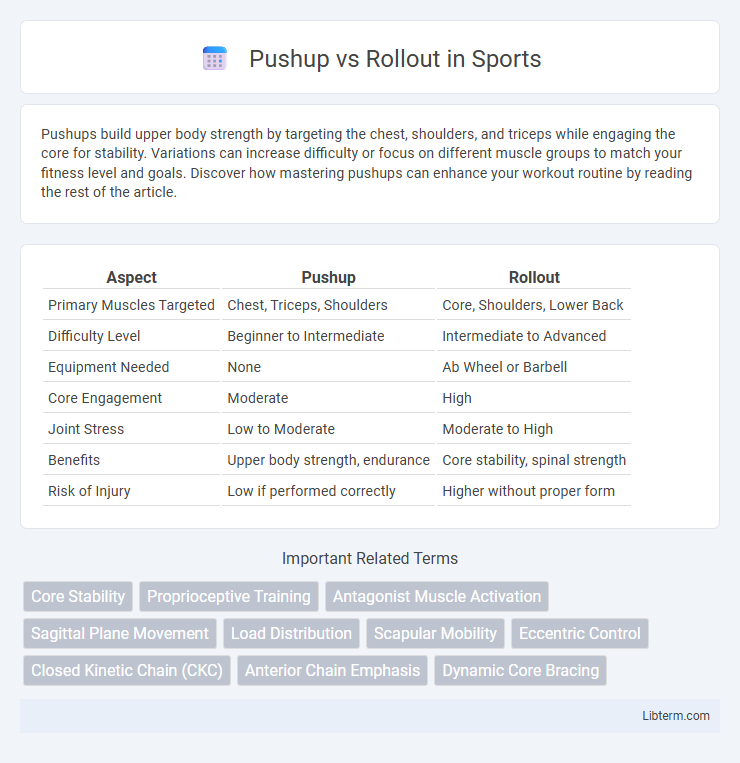Pushups build upper body strength by targeting the chest, shoulders, and triceps while engaging the core for stability. Variations can increase difficulty or focus on different muscle groups to match your fitness level and goals. Discover how mastering pushups can enhance your workout routine by reading the rest of the article.
Table of Comparison
| Aspect | Pushup | Rollout |
|---|---|---|
| Primary Muscles Targeted | Chest, Triceps, Shoulders | Core, Shoulders, Lower Back |
| Difficulty Level | Beginner to Intermediate | Intermediate to Advanced |
| Equipment Needed | None | Ab Wheel or Barbell |
| Core Engagement | Moderate | High |
| Joint Stress | Low to Moderate | Moderate to High |
| Benefits | Upper body strength, endurance | Core stability, spinal strength |
| Risk of Injury | Low if performed correctly | Higher without proper form |
Introduction to Pushups and Rollouts
Pushups primarily target the chest, shoulders, triceps, and core muscles, making them a fundamental compound exercise for upper body strength and endurance. Rollouts, performed with an ab wheel or barbell, intensely engage the core, including the rectus abdominis and obliques, by requiring stability and control throughout the movement. Both exercises improve functional strength, but pushups emphasize upper body pushing power while rollouts focus on core stability and strength.
Muscle Groups Targeted
Pushups primarily target the pectoralis major, triceps brachii, anterior deltoids, and engage the core muscles, including the rectus abdominis and obliques, for stabilization. Rollouts intensely activate the rectus abdominis, transverse abdominis, and obliques while also engaging the shoulders, latissimus dorsi, and lower back muscles to maintain control throughout the movement. Both exercises improve upper body and core strength but emphasize different muscle groups, with pushups focusing more on the chest and arms, and rollouts emphasizing deep core stabilizers.
Equipment Needed
Pushups require no specialized equipment, only relying on body weight and a flat surface, making them highly accessible and convenient for strength training anywhere. Rollouts demand an ab wheel or a barbell with round plates, which are essential to perform the controlled forward movement targeting core muscles. The equipment dependency distinguishes rollouts as more gear-specific, while pushups offer versatile, equipment-free exercise options.
Proper Form and Technique
Maintaining proper form during pushups requires keeping the body in a straight line from head to heels, engaging the core, and lowering the chest until it nearly touches the ground to maximize chest, shoulder, and triceps activation. Rollouts demand controlled movement with a neutral spine, braced core, and preventing sagging hips by extending the arms forward while keeping shoulder blades stable, targeting the abdominals and lower back. Both exercises emphasize core engagement but differ in movement mechanics, making technique crucial to prevent injury and optimize muscle activation.
Difficulty and Progression
Pushups offer scalable difficulty by adjusting hand placement, elevation, and tempo to target different muscle groups progressively. Rollouts demand higher core stability and shoulder strength, making them inherently more challenging for beginners and requiring incremental progression through partial movements or using assisted devices. Mastering pushups builds foundational strength that facilitates advancement to rollouts, aligning with a structured workout progression.
Common Mistakes to Avoid
Neglecting core engagement is a common mistake in both pushups and rollouts, leading to ineffective muscle activation and potential lower back strain. Improper wrist alignment during pushups can cause joint discomfort, while failing to maintain a neutral spine throughout rollouts compromises stability and increases injury risk. Avoiding these errors improves form, maximizes workout efficiency, and enhances overall strength gains.
Injury Risks and Safety Tips
Pushups primarily engage the chest, shoulders, and triceps while posing lower injury risks when performed with proper form, minimizing stress on the wrists and shoulders. Rollouts heavily target the core and require significant stability, increasing the risk of lower back strain if the spine is not kept neutral or if movement extends beyond one's strength capacity. To ensure safety, maintain a neutral spine and controlled movement during rollouts, and keep elbows close to the body during pushups to avoid shoulder impingement.
Benefits of Pushups vs Rollouts
Pushups primarily enhance upper body strength, targeting the chest, shoulders, and triceps while engaging the core for stability, making them ideal for building functional muscle mass. Rollouts focus on core strengthening by activating deep abdominal muscles and improving spinal stability, which helps reduce lower back pain and improve posture. Pushups offer a dynamic, compound movement that increases muscular endurance and promotes cardiovascular benefits, whereas rollouts provide superior isolated core strengthening with minimal upper body involvement.
Which Exercise Suits Your Goals?
Pushups effectively build upper body strength by targeting the chest, shoulders, and triceps, making them ideal for muscle endurance and functional fitness. Rollouts primarily engage the core muscles, especially the abdominals and lower back, providing advanced stability and balance training suited for core strengthening goals. Choose pushups for overall upper body conditioning and rollouts to enhance core stability and prevent injuries.
Conclusion: Pushup or Rollout?
Pushups primarily target the chest, triceps, and shoulders while enhancing upper body strength and stability, making them ideal for overall muscular development. Rollouts engage the core muscles, including the abdominals, lower back, and shoulders, offering superior benefits for core stability and functional strength. Choosing between pushups and rollouts depends on your fitness goals: select pushups for upper body conditioning and rollouts to emphasize core strengthening.
Pushup Infographic

 libterm.com
libterm.com